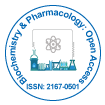
Biochemistry & Pharmacology: Open Access
Open Access
ISSN: 2167-0501
+44-77-2385-9429

ISSN: 2167-0501
+44-77-2385-9429
Perspective - (2024)Volume 13, Issue 1
Biopharmaceuticals represent an essential part of modern medicine, utilizing biological processes and advanced biotechnological methods to develop therapeutic agents. Unlike traditional pharmaceuticals synthesized from chemical compounds, biopharmaceuticals are obtained from living organisms such as bacteria, yeast, or mammalian cells. The production of biopharmaceuticals begins with the identification and isolation of a suitable biological molecule that exhibits therapeutic potential. This could be a protein, peptide, antibody, or nucleic acid, among others. The chosen molecule is then synthesized using recombinant DNA technology, where the gene encoding the desired protein is inserted into host cells.
An essential component of the synthesis of biopharmaceuticals is host organisms. Bacteria such as Escherichia coli are commonly used due to their rapid growth and ease of genetic manipulation. However, they may not always facilitate the production of complex proteins that require post-translational modifications. Yeast, such as Saccharomyces cerevisiae, is preferred due of their capability to perform some post-translational modifications and their capacity to produce large quantities of protein. Mammalian cell lines, such as Chinese Hamster Ovary (CHO) cells, are preferred for producing biopharmaceuticals that require humanlike post-translational modifications.
Once a suitable host organism is selected, the gene encoding the desired protein is cloned into a vector, a carrier molecule that facilitates the insertion of foreign DNA into the host cells. The vector containing the gene of interest is then introduced into the host cells using techniques such as electroporation or viral transduction. Inside the host cells, the gene is transcribed into messenger RNA (mRNA) and translated into protein. Following protein expression, the next step is purification. This process involves separating the desired protein from other cellular components and contaminants. Techniques such as chromatography, filtration, and centrifugation are employed to achieve high purity levels. Purified proteins are then subjected to rigorous quality control measures to ensure their safety, efficacy, and consistency.
Biopharmaceuticals have revolutionized the treatment of various medical conditions, providing targeted therapies with reduced side effects compared to traditional pharmaceuticals. Biopharmaceuticals are commonly used in the treatment of longterm conditions like diabetes, rheumatoid arthritis, and several types of cancer. For instance, insulin, a biopharmaceutical produced using recombinant DNA technology, has transformed the treatment of diabetes by providing a safer and more effective alternative to animal-derived insulin. One well-known type of biopharmaceuticals that is utilized to target particular molecules implicated in disease processes are monoclonal Antibodies (mAbs). They have been instrumental in treating autoimmune disorders, infectious diseases, and certain types of cancer. In order to treat or prevent disease, genetic material is introduced into patients' cells through a process known as gene therapy. Biopharmaceuticals used in gene therapy include viral vectors and nucleic acid-based therapies designed to correct genetic defects or modify cellular functions.
Vaccines represent another important application of biopharmaceuticals. Modern vaccines often utilize recombinant proteins or viral vectors to stimulate the immune system's response against pathogens. Biopharmaceutical-derived vaccines have been essential in controlling infectious diseases such as COVID-19, influenza, and Human Papilloma Virus (HPV). Compared to traditional pharmaceuticals, biopharmaceuticals often present higher specificity and potency, leading to improved therapeutic outcomes and enhanced patient survival rates. This is particularly evident in the treatment of complex diseases such as cancer and autoimmune disorders. While biopharmaceuticals often involve higher production costs compared to conventional drugs, their potential for long-term cost savings is substantial. By reducing hospitalization rates, minimizing the need for invasive procedures, and improving treatment efficacy, biopharmaceuticals contribute to overall healthcare cost containment.
Biopharmaceuticals require extensive regulatory clearance procedures because of concerns about the consistency, safety, and efficacy of their products. It is important to simplify regulatory frameworks without losing patient safety in order to expedite the distribution of novel biopharmaceutical treatments. The high costs associated with biopharmaceutical development and production can limit patient access, particularly in low- and middle-income countries. Initiatives aimed at reducing production costs and increasing global access to biopharmaceuticals is essential for achieving equitable healthcare distribution.
Citation: Hendrik S (2024) Molecular Targeting and Precision Medicine: The Changing Role of Biopharmaceuticals in Healthcare. Biochem Pharmacol.13:355.
Received: 19-Feb-2024, Manuscript No. BCPC-24-32585; Editor assigned: 22-Feb-2024, Pre QC No. BCPC-24-32585 (PQ); Reviewed: 08-Mar-2024, QC No. BCPC-24-32585; Revised: 15-Mar-2024, Manuscript No. BCPC-24-32585 (R); Published: 22-Mar-2024 , DOI: 10.35248/2167-0501.24.13.355
Copyright: © Hendrik S. This is an open-access article distributed under the terms of the Creative Commons Attribution License, which permits unrestricted use, distribution, and reproduction in any medium, provided the original author and source are credited.